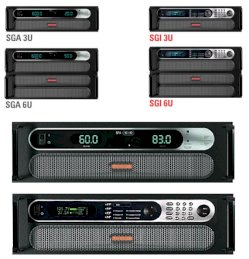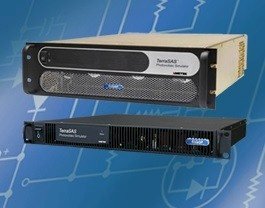System Overview
The TerraSAS is a fully integrated system that can simulate an IV curve with programmable open circuit voltage, Voc, and short circuit current Isc, as required for a wide variety of inverters. The system software also allows the user to change the array fill factor by programming the peak power points, Vmpp and Impp to simulate different solar cell characteristics. This combination of hardware allows the TerraSAS to simulate most test protocols and events that a solar installation will be subjected to. The TerraSAS also allows the user to program the following parameters; irradiance level, temperature value, temperature coefficient, and simulation time to ramp the voltage, temperature or irradiance level.
The TerraSAS control computer runs a Windows 7 operating system. Hardware control is accomplished by an application that communicates directly to the PV simulators using Ethernet, which operate as dedicated IV curve generation processors. The local Graphical User Interface (GUI) is accomplished via another application that provides all of the user controls to the TerraSAS system. Imbedded in the application is the Ethernet parser for remote communication and control. All of the functions available locally through the control computer are also available remotely.
TerraSAS Operation
The TerraSAS system provides an easily programmable means of simulating the response of a PV array. The system provides a turn-key approach to testing the maximum peak power tracking (MPPT) characteristics for inverters and charge controllers. The ability to simulate virtually any fill factor allows the system to characterize the MPPT algorithm with a power source that duplicates any IV array slope characteristic. Test software including items based on the Sandia Labs “Performance Test Protocol for Evaluating Inverters Used in Grid-Connected System” is incorporated to allow for ease in programming various test requirements.
The included software allows modeling of a PV panel without an extensive knowledge of solar array parameters. The main parameters required for a simulation are the open circuit voltage and short circuit current. The software parameters are defined at 25°C and 1000W/m2, so that the resulting IV curve is calculated according to a standard solar cell model. The slope of the IV curve is then modified by the peak power parameters, Vmpp and Impp. Changes to the peak power point parameters allow the shape of the IV curve to be adapted to any fill factor between 0.5 and 0.95.
Once an IV curve has been calculated, changes to the irradiance level or temperature may be changed on the fly so that the behavior of a grid tied inverter can be tested under realistic conditions for cloud shadowing and panel temperature changes. Long-term weather simulations can be run to determine the amount of energy expected in a given situation.
The PV simulator has the ability to simulate ideal IV curves as well as irregular characteristics for peak power tracking that result when solar panels with different output characteristics are paralleled as shown on the two graphs below. The inverter can be optimized for real MPP search modes, because shadowing and temperature changes can be simulated realistically. By programming the changes in irradiance and temperature in a table, dynamic simulation of compressed time profiles of a 24 hour day can be run in a loop to simulate the day and night periods for extended periods of time. The figure below shows a profile with changes in irradiance and temperature over time.
System Power Supplies
The system consists of SGA or DCS modular power supplies, which have been modified for reduced output capacitance and extended bandwidth. The supplies have an output voltage of 80VDC, 600VDC, or 1000VDC with power levels of 1.2kW, 5KW, 10KW or 15KW depending on the output voltage and specific customer power requirements. Each power supply will be in a separate 1U (DCS) or 3U (SGA) high full rack width chassis with the PV simulator board and auxiliary components. Each power supply is programmed through the analog interface from the internal PV simulator board, allowing each one to operate like a separate solar panel or string. This operation will allow a rack to be configured with the required number of channels of separately programmed PV simulator power supplies. For higher power requirements, the supplies are operated in a master/slave mode with the master being programmed through the PV simulator and the slave supplies operating as voltage controlled current sources. This operation allows the output current to be the sum of all of the paralleled supplies. The master supply is programmed through an internal analog interface from the PV simulator, allowing them to be operated as one large supply.












